Bypass in the heating system: why is it needed + how to install it
Through a bypass in the heating system of a modern house, all its key elements are mounted. This simple engineering solution facilitates maintenance and repair of equipment connected to the trunk. And it also increases the efficiency and economy of heating, which is not bad at all, is it?
You want to add a bypass to the heating system, but don’t know how to do it right? We will help you cope with the task - the article discusses the purpose of this element of the heating system and the key points of its installation.
Visual photos and affordable recommendations will help to cope with the self-installation of bypass even for a beginner. In addition, video clips are shown that demonstrate the step-by-step process of assembling the bypass section.
The content of the article:
What is a bypass?
Bypass, or bypass bypass - this is a pipeline that serves to organize the flow of coolant bypassing a specific section of the heating main, or parallel to it.
Most often, some equipment is installed on this site. One end of the bypass pipe is connected to the inlet pipe, the second to the outlet pipe.
Between the bypass and the inlet of the envelope of the device, shutoff valves are installed. It allows you to completely redirect the flow of water along an alternative path, or to regulate the amount of fluid entering the device.
To enable a complete shutdown of the equipment, a crane is installed on the outlet pipe between the outlet of the device and the bypass.
Varieties of heating bypass
Shutoff valves are installed not only at the inlet and outlet pipe, but also on the bypass itself.
Depending on the type of device used, there are three types of bypass pipes:
- unregulated;
- with manual control;
- automatic.
Each type has its own design and application features.

View # 1 - unregulated bypass pipe
Uncontrolled bypass in the heating system is a regular bypass pipe without any additional equipment.
The clearance of the pipe is constantly open and the movement of fluid through it occurs in an uncontrolled mode. Such bypasses are mainly used when connecting radiators.
When designing a heating system, it should be borne in mind that the liquid will pass along the path with the least hydraulic resistance.
Therefore, the diameter of the bore of the unregulated bypass installed vertically should be less than the diameter of the bore of the main line. Otherwise, by gravity fluid moving in the system will go to the bypass located closer.
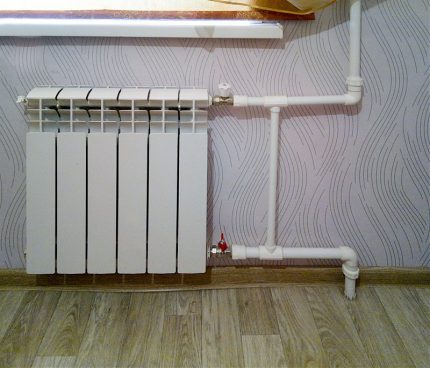
In horizontal heating wiring other laws apply. The hot environment tends to rise up, as it has a lower specific gravity.
Therefore, the bypass of the lower wiring is usually made equal to the main line, and the branch pipe to the radiator is smaller.
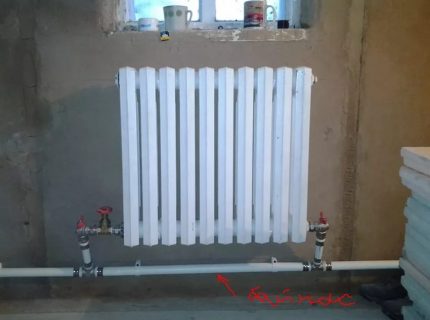
View # 2 - Manual Bypass
A bypass with an installed ball valve is called a manual bypass. A crane of this type is most suitable for a detour, since in the open state it does not reduce the internal clearance of the pipeline.
Therefore, it does not create additional hydraulic resistance to fluid movement.
The use of a locking device allows you to adjust the amount of fluid passing through the bypass. If the valve is completely closed, then the entire stream will go along the main path.
It should be borne in mind that if the working elements of ball valves have the ability to stick to each other, if the device is not used. Therefore, such a crane should be rotated periodically, even if this is not necessary.
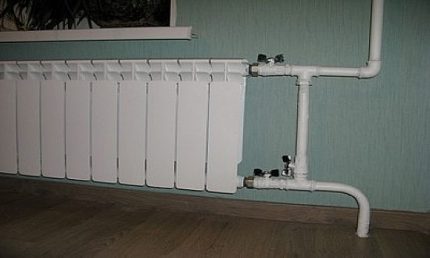
The scope of manually adjustable bypass in the heating system - radiator connection single pipe line and piping of hydraulic pumps.
View # 3 - automatic bypass option
Automatic bypass is installed in the harness of the pump of the gravity heating system. The coolant in such a line can circulate along the circuit without a pumping unit.
An electric supercharger is installed in the system to increase the speed of the fluid, which contributes to less heat loss, uniform heating of the premises, increase the efficiency of the system.
Redirection of fluid flow in the pump harness with automatic bypass occurs without human intervention. When the pump is running, the coolant flows through the unit, and the bypass is shut off.
If the pump stops due to a breakdown or power outage, the coolant flows through the bypass. The immobilized impeller of the unit restricts or completely blocks the flow.
There are two types of automatic bypasses:
- valve;
- injection.
In the first case, a non-return ball valve is mounted in the bypass pipe, which creates the least hydraulic resistance and practically does not interfere with the direct movement of the fluid in gravity mode.
When the pump is turned on, the flow rate increases. The coolant from the outlet pipe enters the highway and diverges in both directions.
Further along the contour, it moves unhindered, and when moving in the opposite direction, it stumbles upon check valve.
Since the hydraulic pressure from the side of the outlet pipe is higher than from the side of the inlet, the ball is firmly pressed against the valve seat and completely covers the pipeline lumen.

The disadvantage of valve bypass is its sensitivity to water purity. The ingress of contaminants - flakes of scale, rust, scale - leads to its failure.
The injection bypass works on the principle of a hydraulic elevator. A pump assembly located on a pipe of smaller diameter is welded into the main trunk of large diameter. In this case, the inlet and outlet nozzles have a continuation inside the pipeline of the highway.
When the pump is turned on, part of the flow enters the inlet diffuser, passes through the unit and accelerates.
The outlet pipe has a slight constriction and is a nozzle through which liquid under pressure is ejected into the main line at high speed.
Behind the cut of the outlet pipe (in the direction of the coolant in the main), a vacuum region is created. Due to this, the bypass fluid is drawn in. A jet emanating under pressure carries the environment along with it, transferring kinetic energy to it.
Thus, the entire stream rushes further along the highway with acceleration. This directional movement of the liquid eliminates the occurrence of a reverse flow.
If the pump does not work, the coolant passes quietly through the bypass in the natural circulation mode.
[caption id = "attachment_13222" align = "alignnone" width = "430"] The impulse to the movement of the heat carrier line with an injection bypass is given by the energy of the water jet.Such a device is not afraid of a slight coolant contamination, since it does not have devices with precisely fitted parts (ball-seat) [/ caption]
The impulse to the movement of the heat carrier line with an injection bypass is given by the energy of the water jet.Such a device is not afraid of a slight coolant contamination, since it does not have devices with precisely fitted parts (ball-seat) [/ caption]Purpose of the bypass pipeline
The main purpose of the bypass section is to maintain circulation in the heating main in the event of a breakdown in the connected unit or a power outage.
[adinserter name = "mobile: insert in text - 5"]Any device connected via bypass can be disconnected from the hydraulic line by simply shutting off two valves - at the inlet and outlet. After that, the entire flow of coolant will go through the bypass pipe.
The device, disconnected from the highway, calmly repair or perform scheduled maintenance. You can completely detach it and replace it with a new one. In this case, you do not need to stop the system and drain the entire coolant.
[adinserter name = "desktop: paste in text - 3"]In an individual heating system, bypass is used in the following cases:
- Insertion of radiators into a single pipe line;
- Binding [link_webnavoz]circulation pump;
- Connection distribution manifold with the device of water heated floors;
- Organization of a small circulation loop when using a solid fuel boiler.
Depending on the application, the bypass connection has its own characteristics.
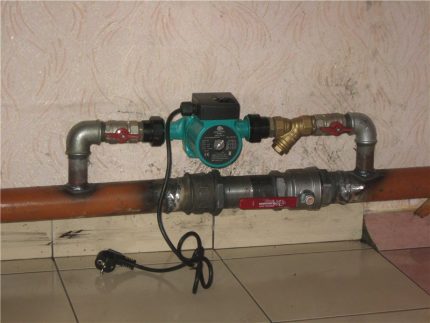
Case # 1 - for a heating radiator
Connecting radiators via bypass is carried out only in single pipe system.
For double pipe system and collector wiring the insertion of the bypass pipes does not make sense. The heating batteries in them are connected in parallel and water of the same temperature is supplied to each directly from the supply line.
The failure of one of the heating circuits, in the presence of shut-off valves, does not affect the operability of the rest of the system.
In a one-pipe system, due to the sequential connection of heat-releasing elements, water is cooled as it passes through the circuit. The higher the heat dissipation of the battery, the colder the liquid will be at the outlet.
If bypasses are not provided in the single-pipe wiring, the first radiator will take the maximum amount of heat and be too hot, and slightly warm water will go through the last.
A feed and return connection with a jumper near each battery divides the flow into two parts. One goes to the radiator and gives off thermal energy.
The second, keeping the temperature, flows along the bypass and is connected at the outlet with the flow from the heating battery. Thus, it is possible to convey a sufficient amount of thermal energy even to the latter in the chain of radiators.
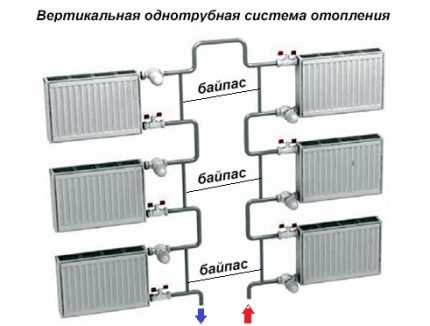
Situation # 2 - when connecting the pump
It makes sense to connect the circulation pump through the bypass only in a system adapted for the gravity flow of water.
An accelerating manifold must be arranged, the necessary slopes and sufficient pipe diameters are observed. The circulation pump in such a line is installed to increase its efficiency.
If the heating system was originally conceived as forced, then when the power is cut off or the pump breaks, it will not be able to function in any case.
The coolant will not circulate without a distillation unit. Therefore, in such a line the pump is installed without a bypass - in a straight line.
A feature of connecting the pump through the bypass is the possibility of a countercurrent in the bypass and the appearance of a closed circulation loop around the bypass pump.
Therefore, shut-off valves, such as ball valves or non-return valves, must be installed in the bypass pipe.
When the pump is running, such equipment completely covers the bypass pipe clearance (valve - automatically, valve - manually). If the pump stops, the bypass opens and convection of the heat transfer medium occurs.
An exception is the injection bypass, the design and principle of operation of which eliminates the reverse movement of the liquid.
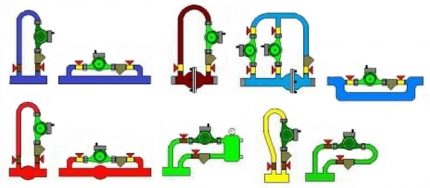
Situation # 3 - when installing underfloor heating
The bypass when connecting underfloor heating is part of the mixing unit. Therefore, it is used constantly, and without it, floor heating will not function normally.
Water in the supply line can reach 80 ° C, and in the underfloor heating circuit it must not exceed 45 ° C. To prepare the coolant, a mixing unit with a three-way valve is used, which passes only the required amount of hot water.
The rest of the flow is bypassed, mixed with chilled water leaving the collector and goes further along the line to the boiler.

Situation # 4 - in the line with a solid fuel boiler
Using a bypass in the piping of the solid fuel boiler, a small coolant circuit is formed. The contour is connected to the supply pipe with the most heated coolant on the one hand, and to the three-way valve mounted on the return on the other.
The valve mixes the chilled water coming from the heat transfer circuits with the hot bypass coolant. Liquid is passed to the boiler whose temperature is not lower than 50 ° C.
Such a piping is necessary when using a solid fuel boiler, because when cold water enters the boiler, condensate forms on the steel walls of the furnace. This leads to corrosion and the rapid failure of the heating unit.
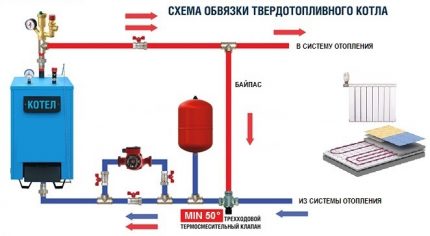
Hot water enters the mixing valve through the bypass bypass section to heat the liquid coming from the system to a temperature that prevents the formation of condensate and corrosion on the boiler walls
Situation # 5 - when installing bypass pipes
Installing different types of bypass in a heating system has its own characteristics.
When connecting radiators:
- The diameter of the bypass pipe is selected one size smaller than the main pipeline;
- The jumper should be installed as close to the radiator as possible;
- It is forbidden to put the crane on the bypass in apartment buildings.
Installation of the radiator bypass can be carried out both when installing a new heating system, and when upgrading an existing one. For this, nozzles of the corresponding diameters, two tees and stop valves are prepared.
One of the device options is installed on the inlet pipe:
- ball valvewhich does not create resistance and allows you to skip the entire passing stream;
- valve - for manual adjustment of the coolant volume;
- combination of ball valve and automatic thermostat - the amount of water passing to the radiator is regulated without human intervention.
A ball or stopcock is installed on the outlet pipe.
Elements are interconnected for welding or threading. In any case, it is necessary to ensure complete tightness of the joints, after assembly, conduct a test and eliminate leaks.

When connecting the pump, the bypass is most often part of the main line. Since it ensures the flow of the coolant in the natural circulation mode, in no case should one narrow its inner diameter.
The pump is mounted on a bypass pipe, the diameter of which may be less than or equal to the diameter of the main line. Subtleties correct circulation pump installation considered in our other article.
For installation, it is easier to purchase a ready-made pump unit of the required size and configuration. This will ensure the correct position of all elements and reliable connections.
However, the independent manufacture of the isolation of the pumping unit is not difficult, if you follow some rules.
The pump should be oriented so that the impeller axis is horizontal and the terminal box cover facing up.
So they provide free access to the terminals to which power is connected, and exclude liquid from entering them if leaks occur.
A high-quality non-return valve or ball valve is mounted in the bypass section to ensure full flow through the pump and to prevent the reverse movement of fluid along the bypass.

Conclusions and useful video on the topic
Errors in the installation of the radiator bypass, which lead to poor heating of the heat transfer element:
Why it is impossible to install a shut-off valve on the bypass of the radiator in an apartment building:
How to assemble a bypass pipe with a pump in such a way that it is convenient to disassemble an already installed and connected product and carry out scheduled maintenance of elements and repairs:
A simple engineering solution - bypass - allows you to make the heating system the most efficient and achieve a comfortable thermal regime in all rooms.
Failure of individual elements of the highway or a power outage will not cause big problems. The coolant will circulate along the highway and the house will be warm.
Are you doing the self-installation of the bypass and want to find out something? You can ask your questions in the comments to this article.
Or do you have a positive build experience? Share it, please. Perhaps some of the home masters will be able to avoid mistakes thanks to your recommendations.

 Features of flushing the heating system: an overview of the best ways
Features of flushing the heating system: an overview of the best ways 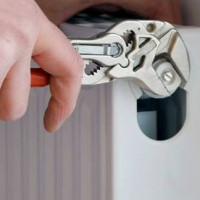 Removing air from the heating system: how to bleed air
Removing air from the heating system: how to bleed air 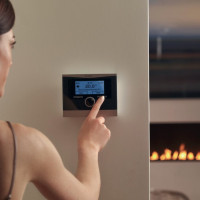 Thermostat for heating boiler: operating principle, types, connection diagrams
Thermostat for heating boiler: operating principle, types, connection diagrams  How to pressure test a heating system with your own hands
How to pressure test a heating system with your own hands 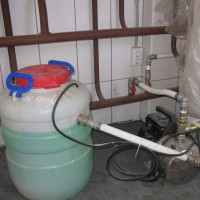 Filling the heating system with coolant: how to fill with water or antifreeze
Filling the heating system with coolant: how to fill with water or antifreeze 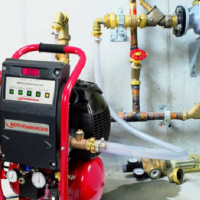 Flushing gas heating systems: flushing methods and procedure
Flushing gas heating systems: flushing methods and procedure  How much does it cost to connect gas to a private house: the price of organizing gas supply
How much does it cost to connect gas to a private house: the price of organizing gas supply  The best washing machines with dryer: model rating and customer tips
The best washing machines with dryer: model rating and customer tips  What is the color temperature of light and the nuances of choosing the temperature of the lamps to suit your needs
What is the color temperature of light and the nuances of choosing the temperature of the lamps to suit your needs  Replacement of a geyser in an apartment: replacement paperwork + basic norms and requirements
Replacement of a geyser in an apartment: replacement paperwork + basic norms and requirements
I came across the concept of bypass at work and at home. Bypass in my house in every room near the heating battery. We spied such a system on our friends and also made ourselves. Now I already know from the article that we have a bypass type - manually controlled (i.e. with faucets). It is very convenient and practical. If it is necessary to change the heating battery, even during the heating period, the taps are closed and water does not enter the battery and goes forward flow.We connected the battery, opened the taps and water flows through the battery. In addition, by the principle of bypass, I also connected a heated towel rail in the bathroom.
We want to put a bypass. Our control complex refuses, referring to the fact that "not allowed." The batteries are connected in series from a room to the kitchen. The battery in the kitchen is not warming well. Riser c01 ′ to batteries 3/4. Are there any norms. documents or tech. conditions to put a bypass? Single pipe system with top feed House since 1960 Thank.
As I always say, and I will not stop repeating that answers from any authorities to which you apply must be requested in writing. The answer in the form of “not supposed” in the oral form is more like that people are simply not willing to deal with your problem.
First of all, I recommend not to solve the problem on your own, but to involve the Criminal Code in its resolution, as these are their responsibilities. It is possible that you need to replace the pipe between the two radiators or it is easier to clean the pipe. Here, let the Criminal Code decide how to fix the problem, a written application is required from you, in which the problem will be indicated.
You can put a bypass, it is not prohibited by the standards, but in this case it will be the elimination of the symptom, and not the source of the problem.
The bypass video on the circulation pump shows how to install the sump and the jar box of the circulation pump.
Hello. Often I see, recently, as a locksmith is doing in apartment buildings, instead of a bypass, they make a straight pipe with leads to the radiator and weld a bolt into the pipe opposite the output to the radiator. Is this right, what consequences can there be?
Hello. Just in case, I’ll clarify - “bolt”, are you talking about a fitting?